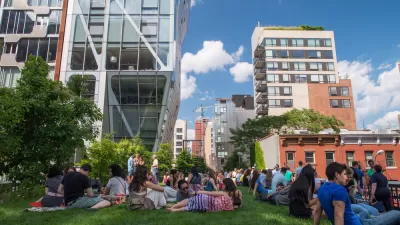It’s difficult to grow a city. Tax revenues limit budgets and there are trade-offs involved in how to spend those resources. Any city trying to allocate resources to grow needs to know who moves.

Young adults, between 16-35, move more than anyone else.
It's difficult to grow a city. Tax revenues limit budgets and there will always be trade-offs involved in how to spend those resources. Local governments need to decide how to spend those funds to run their cities to provide public services and make their cities attractive to people who are choosing where to live.
In Triumph of the City, Edward Glaeser critiques Richard Florida's work on what it takes to create an appealing city. Florida's The Rise of the Creative Class highlights the benefits of producing a city that appeals to younger people by supporting a community of artistic, creative people. Glaeser argues, "There are roughly three times as many people in their thirties, forties and fifties as there are in their twenties, so it would be a mistake for cities to think that they can survive solely as magnets for the young and hip." He contends that this larger more influential population should command more funds and attention. He goes on to tell his readers that, while efforts to attract people in their 20s may be a good in-and-of-themselves, any dollars spent attracting this population are dollars that would be better spent on the concerns of the more numerous older adults.
That the 30-year span between 30 and 60 makes up a larger percentage of the population than that of people in their twenties is undeniable. It’s a stretch to think you can appeal to the interests of 32-year-olds and, at the same time, meet the needs of the generation who gave birth to them. But the place where this argument falls apart is in the age groups that cities should try to influence. America contains many people in their forties and fifties but those cohorts don’t move at anywhere near the rates of their younger countrymen.
According to the most recent Census, the population most likely to move and to desire to move is between the ages of 16 – 34. People are most likely to move to another county when they are between the ages of 20 and 24.
Marketers in any number of different industries know that a disproportionate amount of time and dollars is focused on 18- to 35-year-olds. This is not just out of some desire by brands to seem cool. It has to do with initial decisions and the habits they establish. Consumers that have already made up their minds about a brand, a product, a service, or a place are harder to influence than people who are participating in a market for the first time. It's much easier to get a customer to start with you than to switch to you after they've already created habits and preferences.
This is not to say that there's never a time to seek out 40 and 50 year old consumers. Many companies target older consumers because they can be underserved or ignored by their competitors.
In cities, however, a very different dynamic exists. Older people are not ignored they actually influence local government disproportionately as they are more likely to vote and be involved in with the local government. Cities make efforts to serve an older demographic because the governments themselves are made up of older (mostly male) people who are elected by disproportionately older people.
If a city wants to reach out to a group of possible new citizens who aren't getting the attention others are, a population that makes up a disproportionate segment of the winnable market, they should not seek to appeal to older residents who won’t move and are already getting the lion’s share of the attention. They should target the people who are likely to move.

Planetizen Federal Action Tracker
A weekly monitor of how Trump’s orders and actions are impacting planners and planning in America.

Map: Where Senate Republicans Want to Sell Your Public Lands
For public land advocates, the Senate Republicans’ proposal to sell millions of acres of public land in the West is “the biggest fight of their careers.”

Restaurant Patios Were a Pandemic Win — Why Were They so Hard to Keep?
Social distancing requirements and changes in travel patterns prompted cities to pilot new uses for street and sidewalk space. Then it got complicated.

Platform Pilsner: Vancouver Transit Agency Releases... a Beer?
TransLink will receive a portion of every sale of the four-pack.

Toronto Weighs Cheaper Transit, Parking Hikes for Major Events
Special event rates would take effect during large festivals, sports games and concerts to ‘discourage driving, manage congestion and free up space for transit.”

Berlin to Consider Car-Free Zone Larger Than Manhattan
The area bound by the 22-mile Ringbahn would still allow 12 uses of a private automobile per year per person, and several other exemptions.
Urban Design for Planners 1: Software Tools
This six-course series explores essential urban design concepts using open source software and equips planners with the tools they need to participate fully in the urban design process.
Planning for Universal Design
Learn the tools for implementing Universal Design in planning regulations.
Heyer Gruel & Associates PA
JM Goldson LLC
Custer County Colorado
City of Camden Redevelopment Agency
City of Astoria
Transportation Research & Education Center (TREC) at Portland State University
Camden Redevelopment Agency
City of Claremont
Municipality of Princeton (NJ)





























